2014 YAMAHA FZS SVHO seats
[x] Cancel search: seatsPage 85 of 108
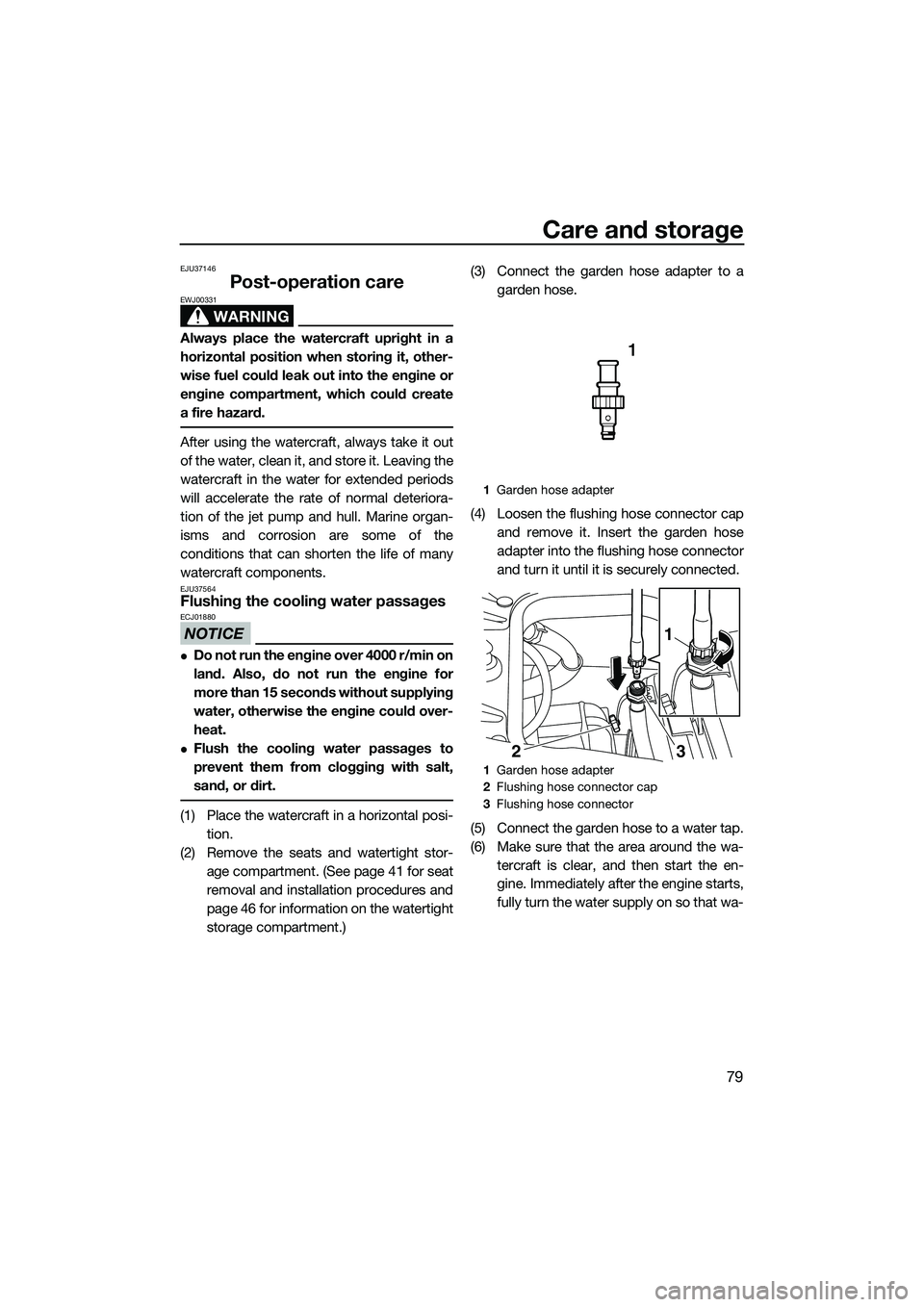
Care and storage
79
EJU37146
Post-operation care
WARNING
EWJ00331
Always place the watercraft upright in a
horizontal position when storing it, other-
wise fuel could leak out into the engine or
engine compartment, which could create
a fire hazard.
After using the watercraft, always take it out
of the water, clean it, and store it. Leaving the
watercraft in the water for extended periods
will accelerate the rate of normal deteriora-
tion of the jet pump and hull. Marine organ-
isms and corrosion are some of the
conditions that can shorten the life of many
watercraft components.
EJU37564Flushing the cooling water passages
NOTICE
ECJ01880
Do not run the engine over 4000 r/min on
land. Also, do not run the engine for
more than 15 seconds without supplying
water, otherwise the engine could over-
heat.
Flush the cooling water passages to
prevent them from clogging with salt,
sand, or dirt.
(1) Place the watercraft in a horizontal posi-tion.
(2) Remove the seats and watertight stor- age compartment. (See page 41 for seat
removal and installation procedures and
page 46 for information on the watertight
storage compartment.) (3) Connect the garden hose adapter to a
garden hose.
(4) Loosen the flushing hose connector cap and remove it. Insert the garden hose
adapter into the flushing hose connector
and turn it until it is securely connected.
(5) Connect the garden hose to a water tap.
(6) Make sure that the area around the wa- tercraft is clear, and then start the en-
gine. Immediately after the engine starts,
fully turn the water supply on so that wa-
1Garden hose adapter
1 Garden hose adapter
2 Flushing hose connector cap
3 Flushing hose connector
23 1
UF3K70E0.book Page 79 Tuesday, November 5, 2013 8:44 AM
Page 86 of 108
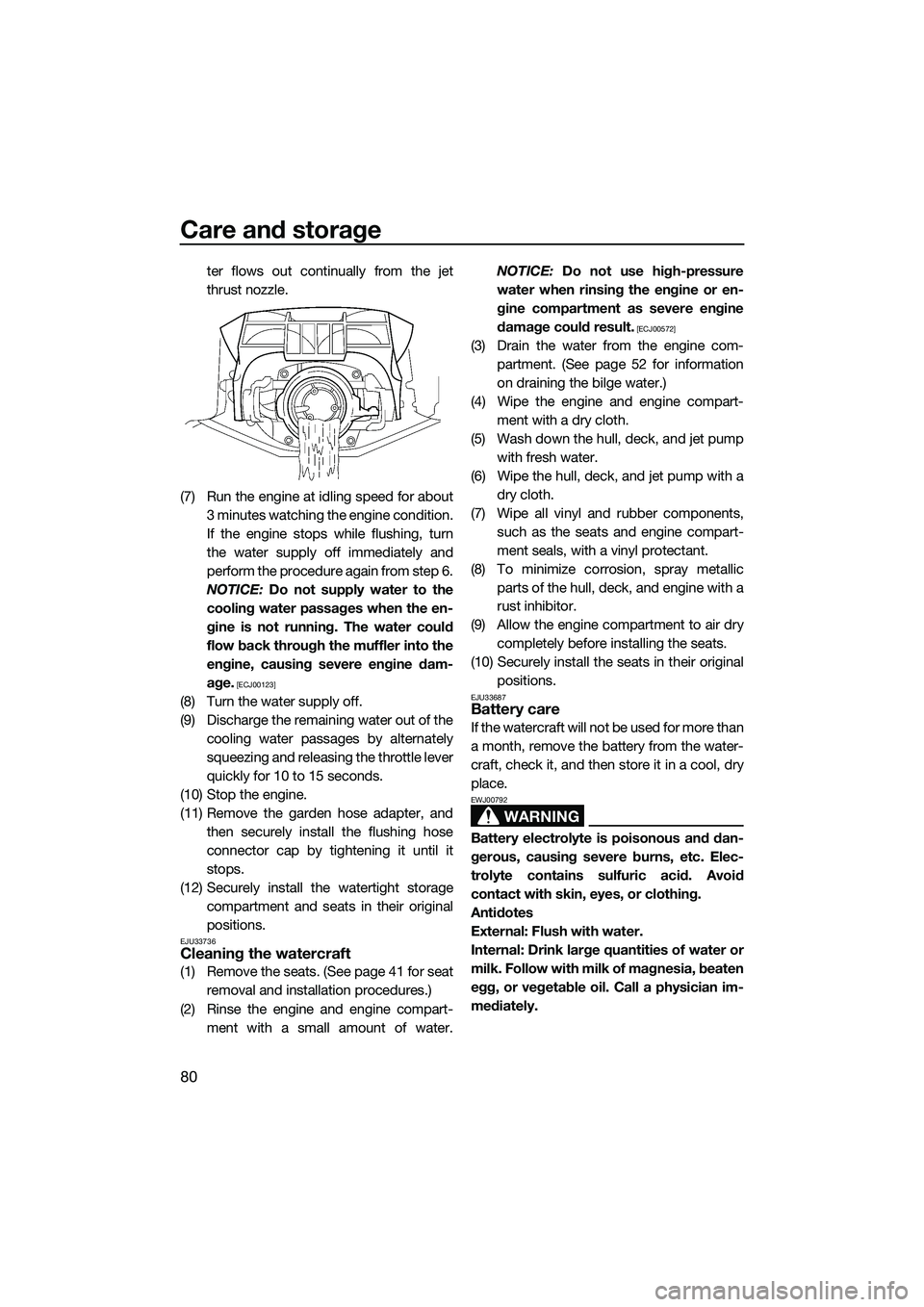
Care and storage
80
ter flows out continually from the jet
thrust nozzle.
(7) Run the engine at idling speed for about 3 minutes watching the engine condition.
If the engine stops while flushing, turn
the water supply off immediately and
perform the procedure again from step 6.
NOTICE: Do not supply water to the
cooling water passages when the en-
gine is not running. The water could
flow back through the muffler into the
engine, causing severe engine dam-
age.
[ECJ00123]
(8) Turn the water supply off.
(9) Discharge the remaining water out of the cooling water passages by alternately
squeezing and releasing the throttle lever
quickly for 10 to 15 seconds.
(10) Stop the engine.
(11) Remove the garden hose adapter, and then securely install the flushing hose
connector cap by tightening it until it
stops.
(12) Securely install the watertight storage compartment and seats in their original
positions.
EJU33736Cleaning the watercraft
(1) Remove the seats. (See page 41 for seatremoval and installation procedures.)
(2) Rinse the engine and engine compart- ment with a small amount of water. NOTICE:
Do not use high-pressure
water when rinsing the engine or en-
gine compartment as severe engine
damage could result.
[ECJ00572]
(3) Drain the water from the engine com- partment. (See page 52 for information
on draining the bilge water.)
(4) Wipe the engine and engine compart- ment with a dry cloth.
(5) Wash down the hull, deck, and jet pump with fresh water.
(6) Wipe the hull, deck, and jet pump with a dry cloth.
(7) Wipe all vinyl and rubber components, such as the seats and engine compart-
ment seals, with a vinyl protectant.
(8) To minimize corrosion, spray metallic parts of the hull, deck, and engine with a
rust inhibitor.
(9) Allow the engine compartment to air dry completely before installing the seats.
(10) Securely install the seats in their original positions.
EJU33687Battery care
If the watercraft will not be used for more than
a month, remove the battery from the water-
craft, check it, and then store it in a cool, dry
place.
WARNING
EWJ00792
Battery electrolyte is poisonous and dan-
gerous, causing severe burns, etc. Elec-
trolyte contains sulfuric acid. Avoid
contact with skin, eyes, or clothing.
Antidotes
External: Flush with water.
Internal: Drink large quantities of water or
milk. Follow with milk of magnesia, beaten
egg, or vegetable oil. Call a physician im-
mediately.
UF3K70E0.book Page 80 Tuesday, November 5, 2013 8:44 AM
Page 91 of 108
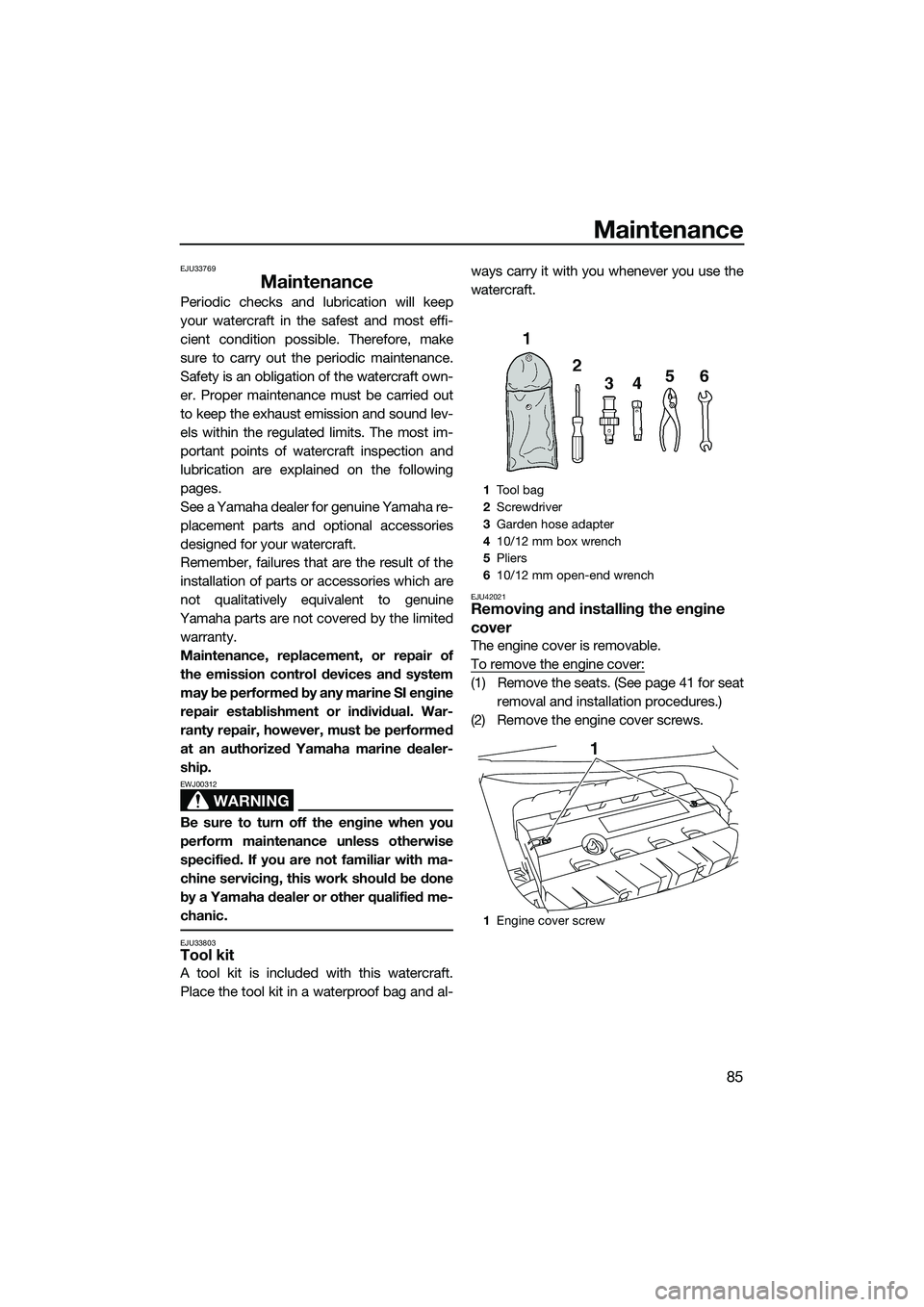
Maintenance
85
EJU33769
Maintenance
Periodic checks and lubrication will keep
your watercraft in the safest and most effi-
cient condition possible. Therefore, make
sure to carry out the periodic maintenance.
Safety is an obligation of the watercraft own-
er. Proper maintenance must be carried out
to keep the exhaust emission and sound lev-
els within the regulated limits. The most im-
portant points of watercraft inspection and
lubrication are explained on the following
pages.
See a Yamaha dealer for genuine Yamaha re-
placement parts and optional accessories
designed for your watercraft.
Remember, failures that are the result of the
installation of parts or accessories which are
not qualitatively equivalent to genuine
Yamaha parts are not covered by the limited warranty.
Maintenance, replacement, or repair of
the emission control devices and system
may be performed by any marine SI engine
repair establishment or individual. War-
ranty repair, however, must be performed
at an authorized Yamaha marine dealer-
ship.
WARNING
EWJ00312
Be sure to turn off the engine when you
perform maintenance unless otherwise
specified. If you are not familiar with ma-
chine servicing, this work should be done
by a Yamaha dealer or other qualified me-
chanic.
EJU33803Tool kit
A tool kit is included with this watercraft.
Place the tool kit in a waterproof bag and al- ways carry it with you whenever you use the
watercraft.
EJU42021Removing and installing the engine
cover
The engine cover is removable.
To remove the engine cover:
(1) Remove the seats. (See page 41 for seat
removal and installation procedures.)
(2) Remove the engine cover screws.
1 Tool bag
2 Screwdriver
3 Garden hose adapter
4 10/12 mm box wrench
5 Pliers
6 10/12 mm open-end wrench
1 Engine cover screw
1
UF3K70E0.book Page 85 Tuesday, November 5, 2013 8:44 AM
Page 92 of 108
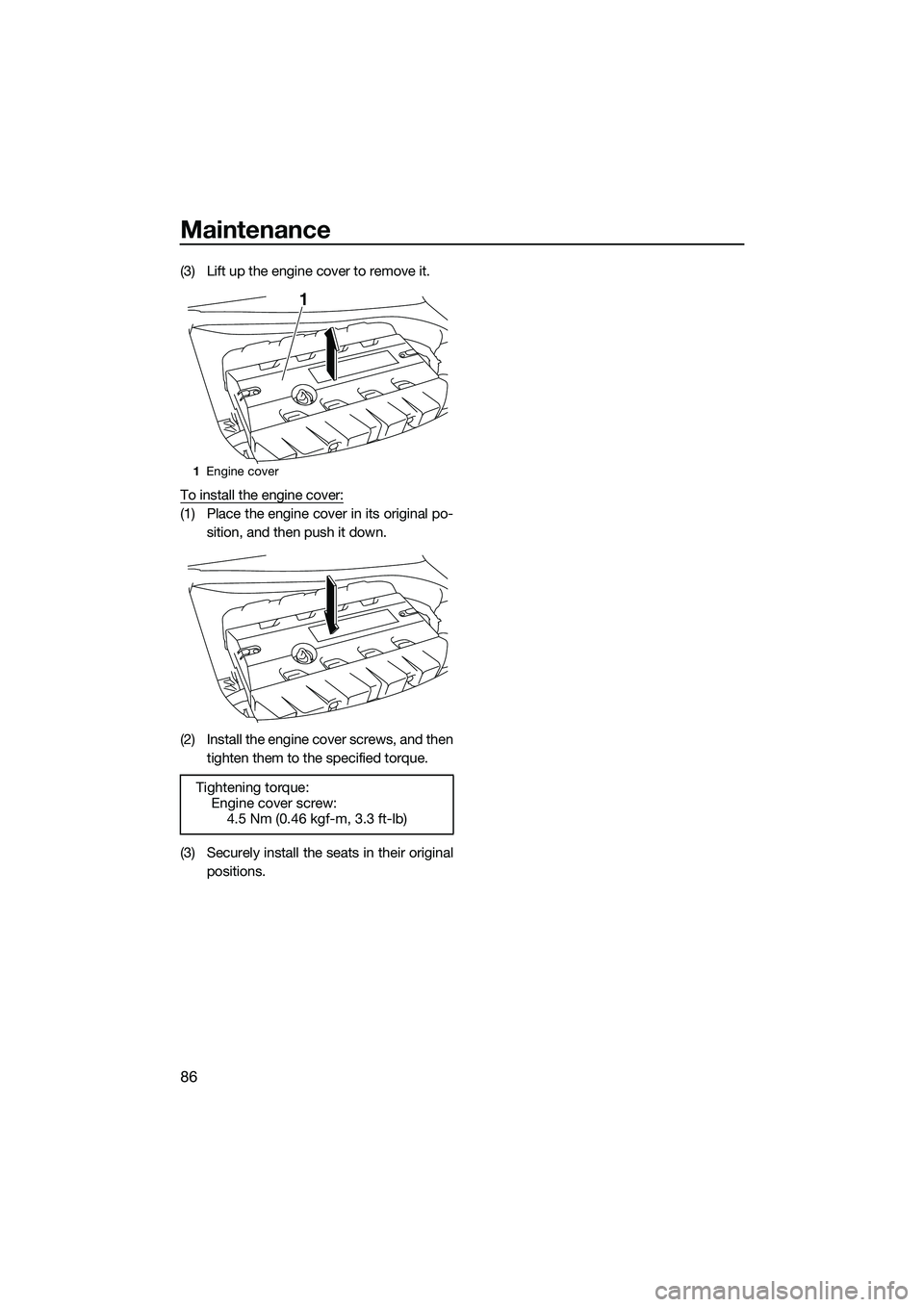
Maintenance
86
(3) Lift up the engine cover to remove it.
To install the engine cover:
(1) Place the engine cover in its original po-sition, and then push it down.
(2) Install the engine cover screws, and then tighten them to the specified torque.
(3) Securely install the seats in their original positions.
1Engine cover
Tightening torque:
Engine cover screw:
4.5 Nm (0.46 kgf-m, 3.3 ft-lb)
1
UF3K70E0.book Page 86 Tuesday, November 5, 2013 8:44 AM
Page 101 of 108
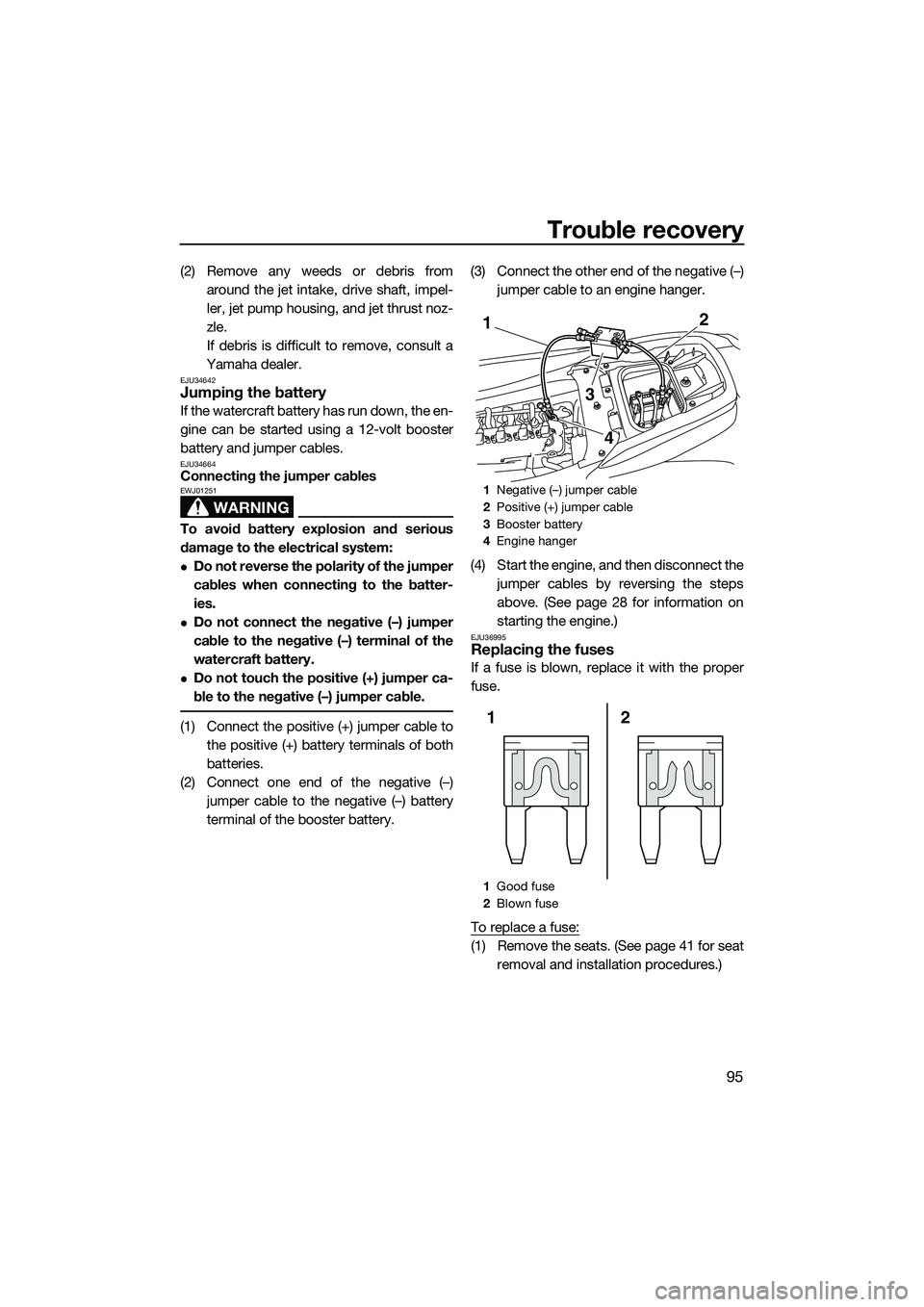
Trouble recovery
95
(2) Remove any weeds or debris fromaround the jet intake, drive shaft, impel-
ler, jet pump housing, and jet thrust noz-
zle.
If debris is difficult to remove, consult a
Yamaha dealer.
EJU34642Jumping the battery
If the watercraft battery has run down, the en-
gine can be started using a 12-volt booster
battery and jumper cables.
EJU34664Connecting the jumper cables
WARNING
EWJ01251
To avoid battery explosion and serious
damage to the electrical system:
Do not reverse the polarity of the jumper
cables when connecting to the batter-
ies.
Do not connect the negative (–) jumper
cable to the negative (–) terminal of the
watercraft battery.
Do not touch the positive (+) jumper ca-
ble to the negative (–) jumper cable.
(1) Connect the positive (+) jumper cable to the positive (+) battery terminals of both
batteries.
(2) Connect one end of the negative (–) jumper cable to the negative (–) battery
terminal of the booster battery. (3) Connect the other end of the negative (–)
jumper cable to an engine hanger.
(4) Start the engine, and then disconnect the jumper cables by reversing the steps
above. (See page 28 for information on
starting the engine.)
EJU36995Replacing the fuses
If a fuse is blown, replace it with the proper
fuse.
To replace a fuse:
(1) Remove the seats. (See page 41 for seatremoval and installation procedures.)
1Negative (–) jumper cable
2 Positive (+) jumper cable
3 Booster battery
4 Engine hanger
1 Good fuse
2 Blown fuse
2
3
1
4
2
1
UF3K70E0.book Page 95 Tuesday, November 5, 2013 8:44 AM
Page 103 of 108

Trouble recovery
97
(7) Securely install the seats in their originalpositions.
If the fuse immediately blows again, the elec-
trical system may be defective. If this occurs,
have a Yamaha dealer service the watercraft.
EJU41822Replacing the bilge pump fuse
If the fuse is blown, replace it with the proper
fuse.
To replace the fuse:
(1) Remove the seats and engine cover. (See page 41 for seat removal and instal-
lation procedures and page 85 for engine
cover removal and installation proce-
dures.)
(2) Remove the plastic ties that are securing the corrugated tube and bilge pump fuse
leads.
TIP:
Be careful not to drop the plastic ties into the
engine compartment.
(3) Pull out the bilge pump fuse holder fromthe rubber cover, and then remove the
fuse cover.
(4) Replace the blown fuse with the spare fuse of the correct amperage.
WARNING! Do not use fuses of a dif- ferent amperage than recommended.
Substitution with a fuse that has an
improper rating can cause extensive
electrical system damage and possi-
ble fire.
[EWJ00803]
TIP:
If the fuse is difficult to remove, use the fuse
puller on the reverse side of the electrical box
1 Good fuse
2 Blown fuse
2
1
1 Bilge pump fuse lead
2 Plastic tie
3 Corrugated tube
213
UF3K70E0.book Page 97 Tuesday, November 5, 2013 8:44 AM
Page 104 of 108
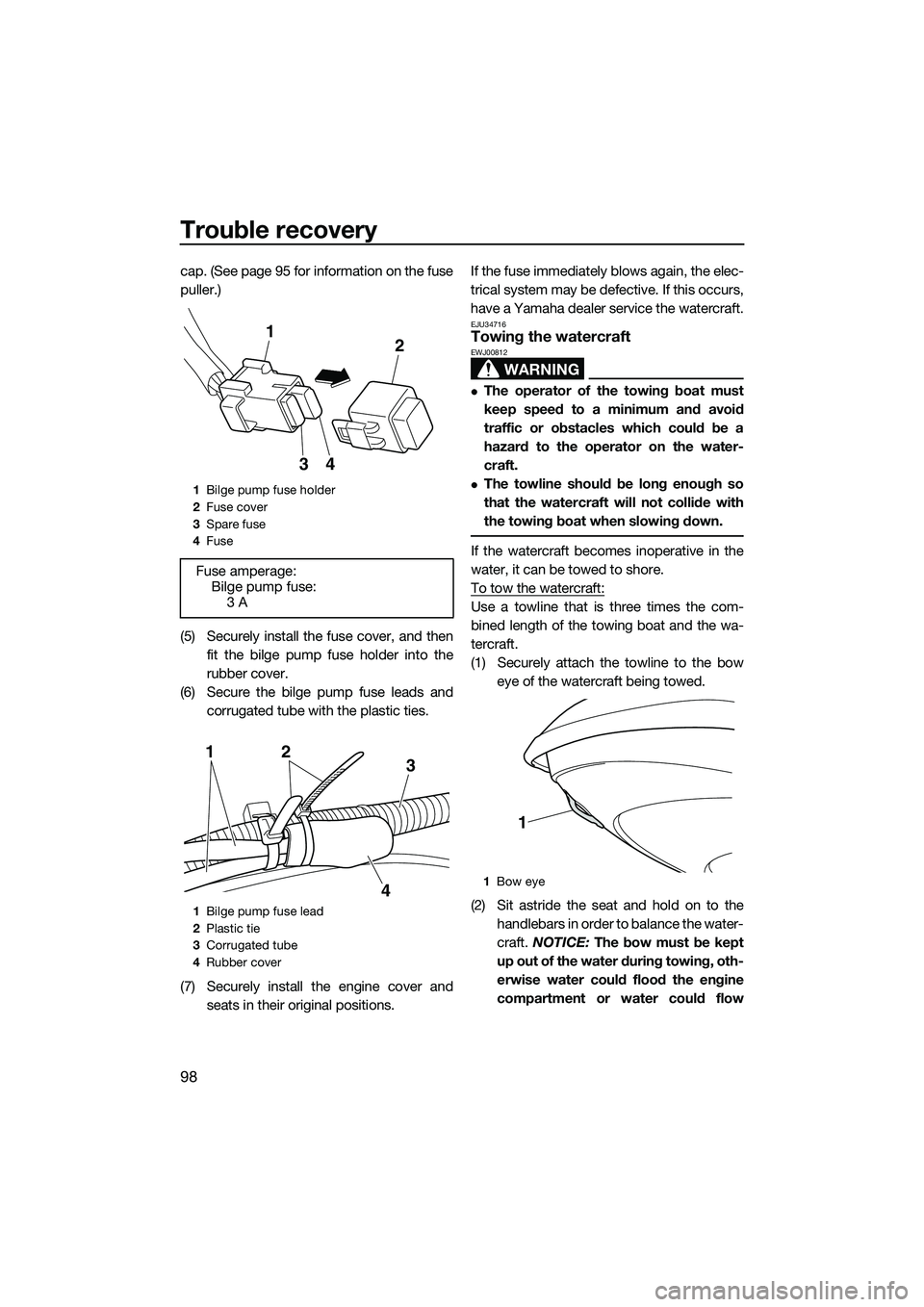
Trouble recovery
98
cap. (See page 95 for information on the fuse
puller.)
(5) Securely install the fuse cover, and thenfit the bilge pump fuse holder into the
rubber cover.
(6) Secure the bilge pump fuse leads and corrugated tube with the plastic ties.
(7) Securely install the engine cover and seats in their original positions. If the fuse immediately blows again, the elec-
trical system may be defective. If this occurs,
have a Yamaha dealer service the watercraft.
EJU34716Towing the watercraft
WARNING
EWJ00812
The operator of the towing boat must
keep speed to a minimum and avoid
traffic or obstacles which could be a
hazard to the operator on the water-
craft.
The towline should be long enough so
that the watercraft will not collide with
the towing boat when slowing down.
If the watercraft becomes inoperative in the
water, it can be towed to shore.
To tow the watercraft:
Use a towline that is three times the com-
bined length of the towing boat and the wa-
tercraft.
(1) Securely attach the towline to the bow
eye of the watercraft being towed.
(2) Sit astride the seat and hold on to the handlebars in order to balance the water-
craft. NOTICE: The bow must be kept
up out of the water during towing, oth-
erwise water could flood the engine
compartment or water could flow
1 Bilge pump fuse holder
2 Fuse cover
3 Spare fuse
4 Fuse
Fuse amperage:
Bilge pump fuse:3 A
1Bilge pump fuse lead
2 Plastic tie
3 Corrugated tube
4 Rubber cover
21
43
213
41Bow eye
1
UF3K70E0.book Page 98 Tuesday, November 5, 2013 8:44 AM
Page 107 of 108
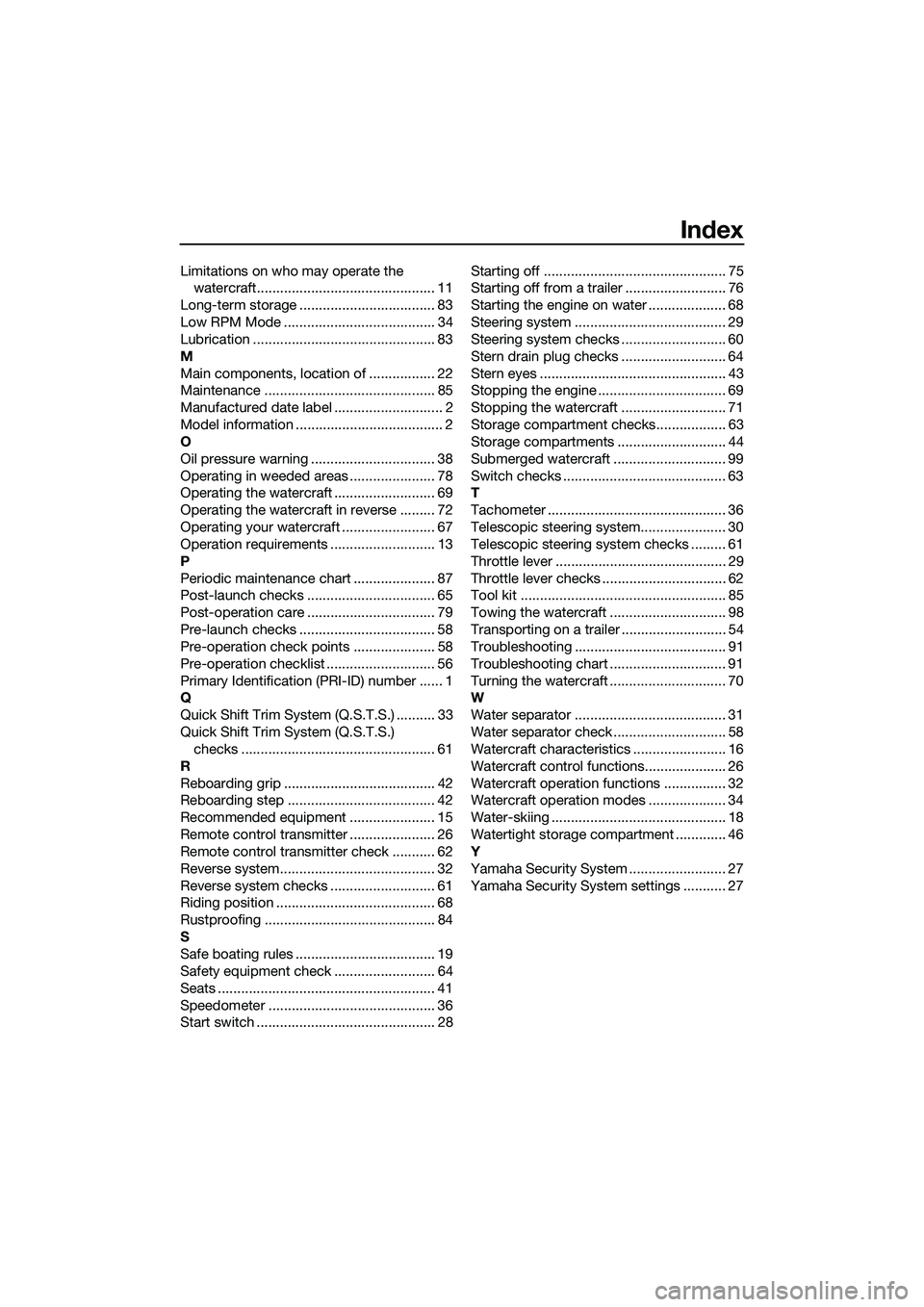
Index
Limitations on who may operate the watercraft.............................................. 11
Long-term storage ................................... 83
Low RPM Mode ....................................... 34
Lubrication ............................................... 83
M
Main components, location of ................. 22
Maintenance ............................................ 85
Manufactured date label ............................ 2
Model information ...................................... 2
O
Oil pressure warning ................................ 38
Operating in weeded areas ...................... 78
Operating the watercraft .......................... 69
Operating the watercraft in reverse ......... 72
Operating your watercraft ........................ 67
Operation requirements ........................... 13
P
Periodic maintenance chart ..................... 87
Post-launch checks ................................. 65
Post-operation care ................................. 79
Pre-launch checks ................................... 58
Pre-operation check points ..................... 58
Pre-operation checklist ............................ 56
Primary Identification (PRI-ID) number ...... 1
Q
Quick Shift Trim System (Q.S.T.S.) .......... 33
Quick Shift Trim System (Q.S.T.S.) checks .................................................. 61
R
Reboarding grip ....................................... 42
Reboarding step ...................................... 42
Recommended equipment ...................... 15
Remote control transmitter ...................... 26
Remote control transmitter check ........... 62
Reverse system........................................ 32
Reverse system checks ........................... 61
Riding position ......................................... 68
Rustproofing ............................................ 84
S
Safe boating rules .................................... 19
Safety equipment check .......................... 64
Seats ........................................................ 41
Speedometer ........................................... 36
Start switch .............................................. 28 Starting off ............................................... 75
Starting off from a trailer .......................... 76
Starting the engine on water .................... 68
Steering system ....................................... 29
Steering system checks ........................... 60
Stern drain plug checks ........................... 64
Stern eyes ................................................ 43
Stopping the engine ................................. 69
Stopping the watercraft ........................... 71
Storage compartment checks.................. 63
Storage compartments ............................ 44
Submerged watercraft ............................. 99
Switch checks .......................................... 63
T
Tachometer .............................................. 36
Telescopic steering system...................... 30
Telescopic steering system checks ......... 61
Throttle lever ............................................ 29
Throttle lever checks ................................ 62
Tool kit ..................................................... 85
Towing the watercraft .............................. 98
Transporting on a trailer ........................... 54
Troubleshooting ....................................... 91
Troubleshooting chart .............................. 91
Turning the watercraft .............................. 70
W
Water separator ....................................... 31
Water separator check ............................. 58
Watercraft characteristics ........................ 16
Watercraft control functions..................... 26
Watercraft operation functions ................ 32
Watercraft operation modes .................... 34
Water-skiing ............................................. 18
Watertight storage compartment ............. 46
Y
Yamaha Security System ......................... 27
Yamaha Security System settings ........... 27
UF3K70E0.book Page 2 Tuesday, November 5, 2013 8:44 AM